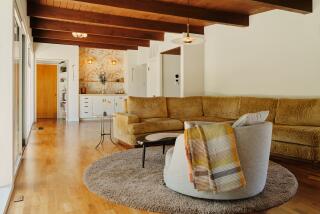1990s Colors: Not Just a Matter of Trendiness
- Share via
QUESTION: I’ve read articles about color forecasts for decorating. Does someone really decide what’s going to be in? Who decides this, why is this done and what are the colors I’m supposed to like in the 1990s?
ANSWER: Color Assn. of the United States (CAUS) and Color Marketing Group (CMG) are two of the organizations that forecast colors. Color forecasts are not simple, trendy decisions made to hasten the obsolescence of clothes, products or furnishings.
These predictions are the result of extensive research into consumer attitudes, political and economical climates, cultural events and current market trends. Experts in color marketing, merchandising and design professions research these trends and predict how they will influence color preferences.
High costs for product development necessitate that industries use color palettes that consumers are more likely to buy. As our world shrinks and borders are opened, there is a need to create palettes that appeal to more nations and cultures. As a result of color forecasting, industries can color-coordinate differing products. For example, new fabrics will match new carpeting, and bathtubs and sinks will be made in the same colors. Imagine trying to find a match if there was no industry coordination as to color choice or selection.
Color organizations are already beginning to focus on palettes for 1992-93. Palettes fall into three categories--established, ascending and forecast colors. Established colors are the safer, traditional colors used previously. Ascending colors are based on the established colors but with some changes (lighter or darker). Forecast colors are the predictions of new color preferences.
Therefore each forecast has “something for everyone” and varying color ranges appropriate for different types of products. Because three categories exist in each year’s palette, color trends will not be too drastic from year to year, especially for major product investments.
The 1990 color palette by the Color Assn. uses richer, more saturated colors. The brighter colors, from previous forecasts (recommended as accents) will now emerge as major colors. Purer green, blue, yellow and purple will probably appear in less frequently used parts of the home. The 1990 reds are “blue-based” reds similar to burgundy.
There is a range of “muddier” yellow-based greens (avocado), gold and rust. The neutrals are beige, tans, off-whites and browns with only a few remaining gray tones. Black is still a dramatic accent. The names of these new colors definitely reflect our changing cultural and international awareness, such as Kenya Green, Ming Green, Osaka Tan, Hokkaido White, El Greco Brown, Blue Strasbourg and New Delhi Blue.
SHERRY PAYNE, ASID
Pasadena
Getting Started on New Look for Home
Q: How do I know where to start improving my environment? I want to make it look better but I don’t know how to. What should I do first?
A: The first step is to determine the feeling that you are most comfortable with. A marvelous vehicle for discovering what your personal “better” may be, are the myriad decorating magazines on the market.
Buy a stack, tear out photos of rooms that appeal to you, rooms that you can visualize yourself or your family living in. Don’t deny yourself anything in this phase. Fantasy has no budget and, should you utlimately hire a designer, an imaginative, resourceful one can achieve the look that you want within your financial limits. Keep in mind the structure of your home and your lifestyle.
When traveling or visiting friends whose homes you like, snap a shot of a whole room or a detail that particularly pleases you. It could be a molding, a vase, a rug, windows, doors, a skylight or stairway or a combination of things that appeal to you.
As your collection of bits and pieces grows, a definite pattern will emerge. Be aware of colors that trigger a good feeling. Pick up paint chips, tack them on the wall and live with them for awhile. Notice the predominant colors that are in your wardrobe. Are these the colors you could surround yourself with?
Your file should be bulging in no time at all, and you’ll be anxious to begin the adventure of improving your environment.
MARIEANN GREEN, ISID
Los Angeles
Don’t Delay Decision on Floor Coverings
Q: When redoing a room from scratch, at what point do you choose the floor covering?
A: It is essential to decide on all floor coverings at the same time that any architectural changes are being considered. Changes such as removing a wall, adding a fireplace hearth, installing new doors, adding a room or redoing a kitchen and bath are important considerations in reaching a decision on the type of floor covering to use.
In as much as the finished product is only as good as the subfloor it is covering, any problems with the subfloor will affect the finished floor. As an example, moisture problems or irregularities will arise if the sub-floor is not treated properly at the onset of construction or remodeling.
In using marble, wood, tile, vinyl or broadloom, you must be aware of traffic patterns and noise so that you can determine whether the material you have selected is practical for your situation.
LILLIAN CHAIN
President
Los Angeles chapter, ASID
Seeks Alternatives for Hated Draperies
Q: I hate draperies in the Southern California climate. What are some options that will still protect furnishings from all that sunlight?
A: There are several ways to protect your furnishings from our bright California sun.
The wide louver “plantation” shutters offer protection and a gracious ambience to any decor. Vertical blinds, both fabric and vinyl, are practical and present a clean contemporary look. Pleated soft shades come in a variety of colors--some with aluminum backing to reflect the sun. They can be raised to any height like a miniblind, and when completely raised, will fit under any valance or top window dressing.
Fabric draped over a heavy rod above the vertical or soft shade offers an alternative to valances and a softer look that works well in more traditional settings.
For additional protection from strong sunlight, many companies offer a translucent window tinting in a variety of shades; however, choose carefully as these tints change the appearance of your fabric colors.
ELEANOR CORKLE, ISID
Palm Springs
This column is prepared by members of the American Society of Interior Designers and International Society of Interior Designers. Readers with questions may write “Design Solutions,” P.O. Box 1033, La Canada, Calif. 91012.


